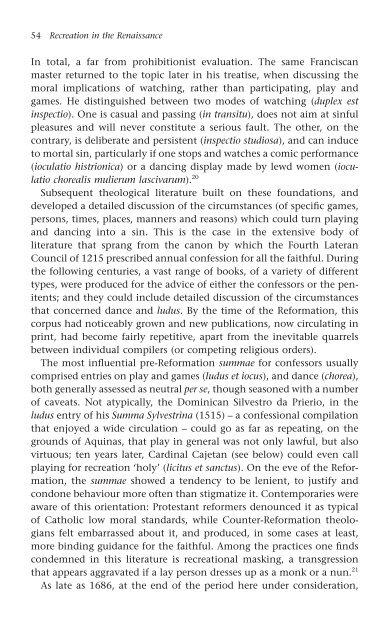Recreation in the Renaissance
Recreation in the Renaissance
Recreation in the Renaissance
- No tags were found...
You also want an ePaper? Increase the reach of your titles
YUMPU automatically turns print PDFs into web optimized ePapers that Google loves.
54 <strong>Recreation</strong> <strong>in</strong> <strong>the</strong> <strong>Renaissance</strong><br />
In total, a far from prohibitionist evaluation. The same Franciscan<br />
master returned to <strong>the</strong> topic later <strong>in</strong> his treatise, when discuss<strong>in</strong>g <strong>the</strong><br />
moral implications of watch<strong>in</strong>g, ra<strong>the</strong>r than participat<strong>in</strong>g, play and<br />
games. He dist<strong>in</strong>guished between two modes of watch<strong>in</strong>g (duplex est<br />
<strong>in</strong>spectio). One is casual and pass<strong>in</strong>g (<strong>in</strong> transitu), does not aim at s<strong>in</strong>ful<br />
pleasures and will never constitute a serious fault. The o<strong>the</strong>r, on <strong>the</strong><br />
contrary, is deliberate and persistent (<strong>in</strong>spectio studiosa), and can <strong>in</strong>duce<br />
to mortal s<strong>in</strong>, particularly if one stops and watches a comic performance<br />
(ioculatio histrionica) or a danc<strong>in</strong>g display made by lewd women (ioculatio<br />
chorealis mulierum lascivarum). 20<br />
Subsequent <strong>the</strong>ological literature built on <strong>the</strong>se foundations, and<br />
developed a detailed discussion of <strong>the</strong> circumstances (of specific games,<br />
persons, times, places, manners and reasons) which could turn play<strong>in</strong>g<br />
and danc<strong>in</strong>g <strong>in</strong>to a s<strong>in</strong>. This is <strong>the</strong> case <strong>in</strong> <strong>the</strong> extensive body of<br />
literature that sprang from <strong>the</strong> canon by which <strong>the</strong> Fourth Lateran<br />
Council of 1215 prescribed annual confession for all <strong>the</strong> faithful. Dur<strong>in</strong>g<br />
<strong>the</strong> follow<strong>in</strong>g centuries, a vast range of books, of a variety of different<br />
types, were produced for <strong>the</strong> advice of ei<strong>the</strong>r <strong>the</strong> confessors or <strong>the</strong> penitents;<br />
and <strong>the</strong>y could <strong>in</strong>clude detailed discussion of <strong>the</strong> circumstances<br />
that concerned dance and ludus. By <strong>the</strong> time of <strong>the</strong> Reformation, this<br />
corpus had noticeably grown and new publications, now circulat<strong>in</strong>g <strong>in</strong><br />
pr<strong>in</strong>t, had become fairly repetitive, apart from <strong>the</strong> <strong>in</strong>evitable quarrels<br />
between <strong>in</strong>dividual compilers (or compet<strong>in</strong>g religious orders).<br />
The most <strong>in</strong>fluential pre-Reformation summae for confessors usually<br />
comprised entries on play and games (ludus et iocus), and dance (chorea),<br />
both generally assessed as neutral per se, though seasoned with a number<br />
of caveats. Not atypically, <strong>the</strong> Dom<strong>in</strong>ican Silvestro da Prierio, <strong>in</strong> <strong>the</strong><br />
ludus entry of his Summa Sylvestr<strong>in</strong>a (1515) – a confessional compilation<br />
that enjoyed a wide circulation – could go as far as repeat<strong>in</strong>g, on <strong>the</strong><br />
grounds of Aqu<strong>in</strong>as, that play <strong>in</strong> general was not only lawful, but also<br />
virtuous; ten years later, Card<strong>in</strong>al Cajetan (see below) could even call<br />
play<strong>in</strong>g for recreation ‘holy’ (licitus et sanctus). On <strong>the</strong> eve of <strong>the</strong> Reformation,<br />
<strong>the</strong> summae showed a tendency to be lenient, to justify and<br />
condone behaviour more often than stigmatize it. Contemporaries were<br />
aware of this orientation: Protestant reformers denounced it as typical<br />
of Catholic low moral standards, while Counter-Reformation <strong>the</strong>ologians<br />
felt embarrassed about it, and produced, <strong>in</strong> some cases at least,<br />
more b<strong>in</strong>d<strong>in</strong>g guidance for <strong>the</strong> faithful. Among <strong>the</strong> practices one f<strong>in</strong>ds<br />
condemned <strong>in</strong> this literature is recreational mask<strong>in</strong>g, a transgression<br />
that appears aggravated if a lay person dresses up as a monk or a nun. 21<br />
As late as 1686, at <strong>the</strong> end of <strong>the</strong> period here under consideration,










